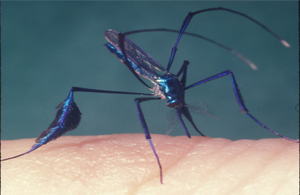
Common mosquito could be a threat for Brazilians
Research by Fiocruz team detected the Zika virus in Culex genus of mosquitoes
15/08/2016
The common mosquito has the same infective capacity as the Aedes aegypti and its population is 20 times greater than Aedes
The common mosquito or black-winged stilt, as the Culex mosquito is known, could bring more risks for the health of Brazilians than was thought. This is because a research by the Oswaldo Cruz Foundation (Fiocruz – PE) found that the insect could also be a vector for the Zika virus and has relevant vector capacity, with the same infective capacity as the Aedes aegypti.
About 500 mosquitoes were collected in Recife and Arcoverde, cities in Pernambuco State, where the State Health Secretary (SES-PE) reported zika cases. The tests, coordinated by Constância Ayres, researcher at the Entomology Department from the Aggeu Magalhães Research Center / Fiocruz (PE), detected the virus in some insects
According to the vice-president of the Brazilian Society of Tropical Medicine (BSTM), researcher in Public Health and chair of the CPqAM/Fiocruz, Dr. Sinval Pinto Brandão Filho, the arboviral diseases, transmitted by mosquitos, are direct and indirectly related to inadequate or poor basic sanitation conditions. Our medical entomology research group, led by colleague Constância Ayres, proved the Culex quinquefaciatus also transmits the zika virus, both through experimental infection and by finding natural infection in collected specimens in areas in Recife, where confirmed cases of Zika have been reported, he explained.
The virus epidemic in Brazil and its connection to microcephaly motivated the research. According to the last report by the Health Ministry, 66,180 fever cases caused by Zika were reported from January to June 2016. In the same period, a death was confirmed in Rio de Janeiro and 5,925 pregnant women were infected. Besides this, from November 8, 2015 and July 23, 2016, laboratory tests detected the virus in 272 of 1,749 pointed microcephaly cases.
This Fiocruz research shows the mosquito population is 20 times greater than the Aedes aegypti. However, the dissemination potential of zika by the Culex mosquito is still being assessed by the institution in ongoing studies about the vector capacity.
The studies are unprecedented and can contribute to other disease control mechanisms. With the new signs, the precaution measures can change, since they are currently focused in combating the dengue mosquito. Dr. Sinval reminds this confirmation that the mosquito can also transmit Aedes diseases means the control dimension becomes much more complex, because the current measures for A. aegypti must maintained, but also increased and redirected to control the Culex, which unlike the Aedes, prefers dirty water, i.e., more than ever before immediate actions in basic sanitation in several regions of the Country must be implemented.…










